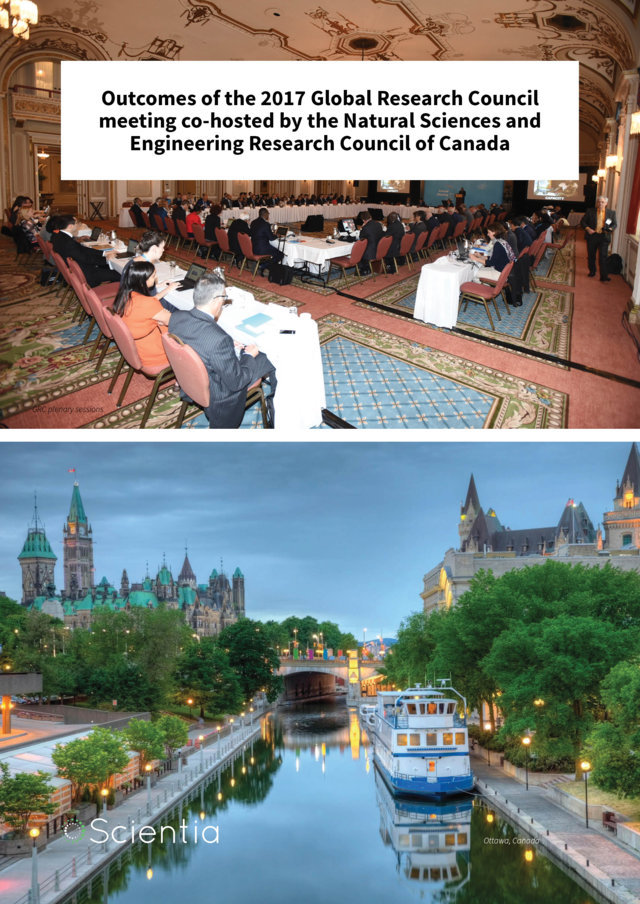Outcomes of the 2017 Global Research Council meeting co-hosted by the Natural Sciences and Engineering Research Council of Canada
Comprising the heads of research funding agencies worldwide, the Global Research Council (GRC) is an organisation dedicated to fostering multilateral research and collaboration across continents to benefit both developing and developed nations. The GRC holds annual meetings to promote the sharing of data and best practices, and to facilitate strong collaboration between funding bodies. The 2017 meeting, held in May, was co-hosted and organised by the Natural Sciences and Engineering Research Council of Canada (NSERC), together with the Consejo Nacional de Ciencia, Tecnología e Innovación Tecnológica of Peru (CONCYTEC), in partnership with the International Development Research Centre (IDRC).
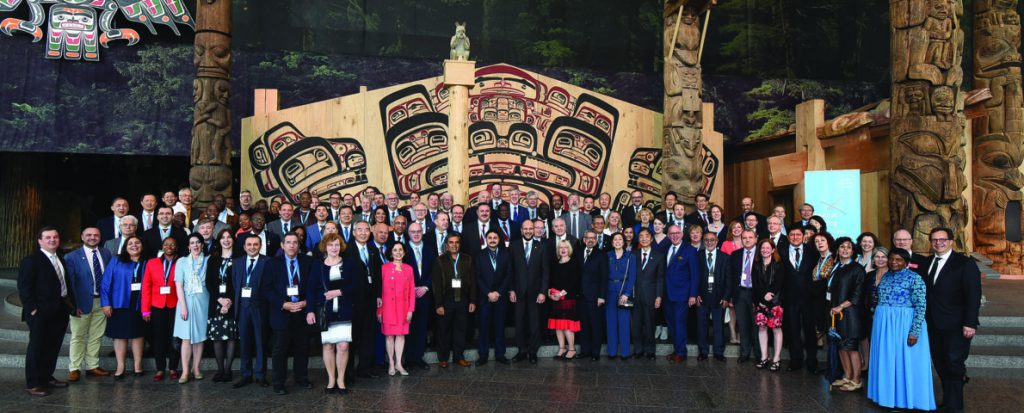
Group photo of the 6th Annual Meeting of the Global Research Council
In this exclusive interview, we had the pleasure of speaking with Dr B. Mario Pinto, President of NSERC, who highlighted the key outcomes of the meeting. In particular, he discussed how to achieve gender equity and diversity in science, ways to assess research impact, and the importance of viewing basic and applied research as one dynamic ecosystem.
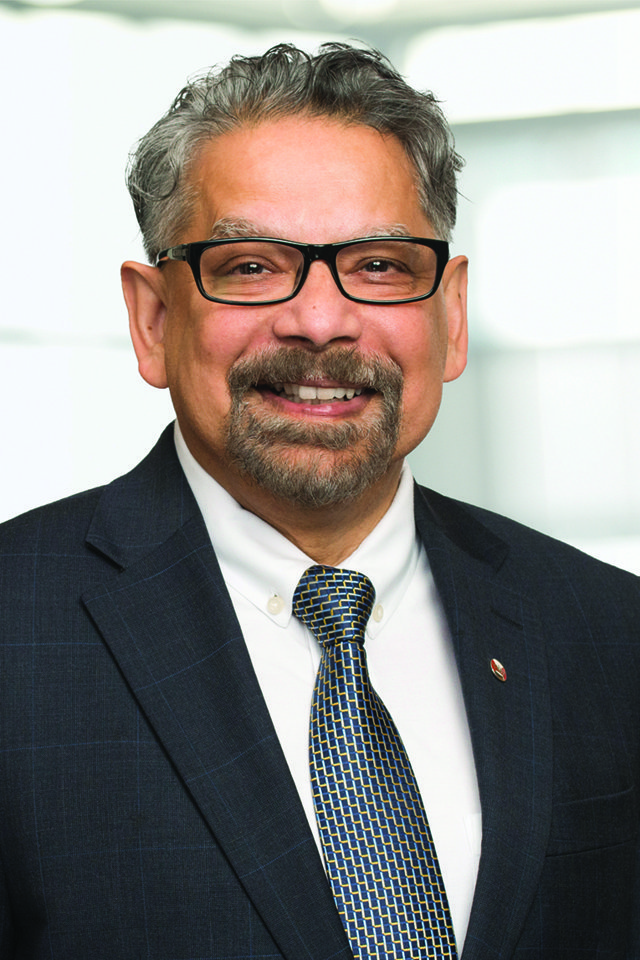
Mario Pinto, President, NSERC
To start, please give us a brief introduction to NSERC, and tell us about your aims, vision and the types of research that you support.
NSERC is a federally funded organisation. It’s one of the three major granting councils in Canada, and its mandate is to fund research in the natural sciences and engineering. At NSERC, we have a budget of $1.2 billion a year, and we fund about 11,500 professors, as well as 30,500 students and postdoctoral fellows, and we also work with about 3,700 industrial partners, who partner with our academics.
Our vision is very simple – to make Canada a country of discoverers and innovators, and that really is the aim of everything we do. We strive for research excellence, both on the discovery side and on the innovation side – and we don’t make a distinction between the two, because we do both of these activities as part of one ecosystem, and we have feedback loops between different sectors to optimise our research inventions if they should arise.
In terms of the types of research, NSERC covers everything in the natural sciences and engineering – including, engineering of different types, e.g., biomedical engineering, biomedical sciences involving cell biology, chemical biology, molecular biology, physiology, and physics, chemistry, biology, mathematical and statistical sciences, geosciences and computational sciences, etc. – so, it really is probably the broadest mandate of the granting councils.
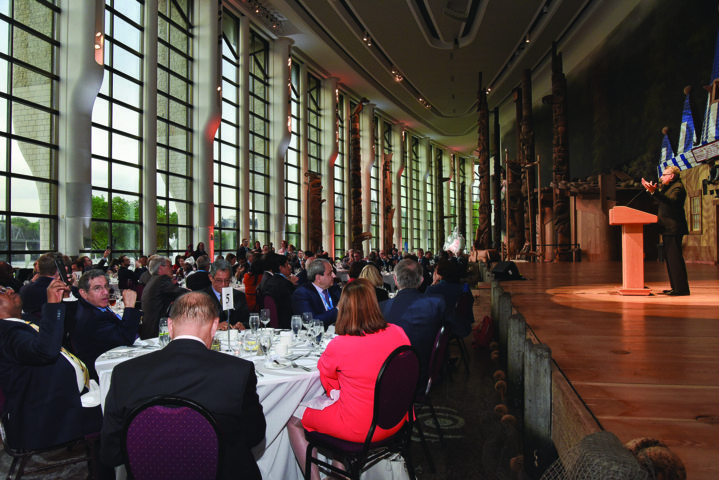
GRC dinner at the Canadian Museum of History
The GRC selected NSERC, in partnership with the National Council of Science, Technology and Technological Innovation of Peru, to co-host the annual meeting in Ottawa. Please tell us about the purpose of this meeting and how it ties in with NSERC’s aims.
The GRC was founded in 2012 and hosts annual meetings. There are bids each year to host the next meeting. NSERC won the bid for this year, together with our co-host, Peru. The objective of all of these meetings is to bring the heads of research councils together to share best practices, develop policies that will guide us into the future, while admitting that we all have different strengths, and also different problems. It is critical that we learn from each other so that we don’t repeat mistakes of the past as we go forward together. In addition, this forum allows us to set up bilateral and multilateral collaborations that address some of the critical issues in research and innovation, and it’s very much a collaborative venture now.
If you want to accomplish something in a reasonable timeframe, generally speaking, collaboration is the way. Even on something very fundamental – as fundamental as quantum physics, for example – because there are bright minds all over the world, tapping into complementarities is really the productive way forward. So, the purpose of the GRC meeting is to bring together the heads of the research agencies. Together, we manage about 80% of the public research funds in the world. We have 70 partner countries on board, and it’s an attempt to provide some direction to our respective clienteles in different countries.
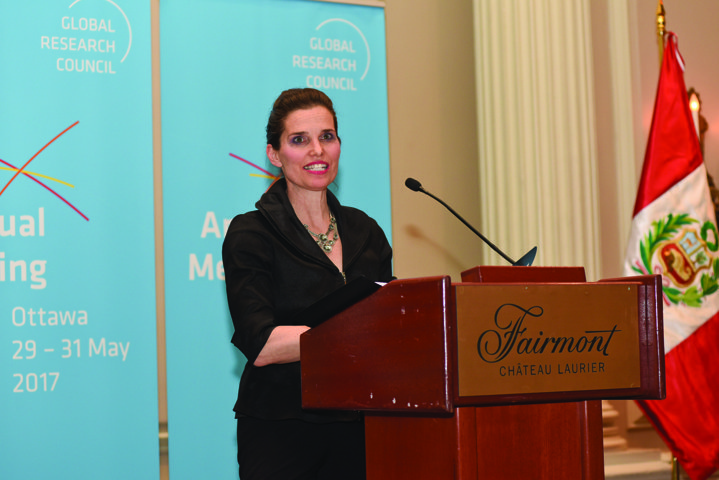
The Honorable Kirsty Duncan, Minister of Science, Canada
The meeting’s first session focused on the dynamic interplay between research and innovation. Please tell us what was discussed on this topic, and what creative ideas arose for boosting the translation of fundamental research findings to innovative new technologies.
This has been a big debate – some have been quick to put into boxes the fundamental research, on the one hand, and what people call ‘applied research’ or ‘innovation’, on the other hand. We feel that this particular categorisation has been restrictive and limiting.
So, what we discussed in great detail was this artificial distinction between fundamental research and applied research, and we pretty much agreed with each other. We also had a keynote lecture from an eminent scientist at Harvard, who supported this view that one should not obsess about the difference between basic and applied research. One should focus instead on doing excellent research and in fact, that’s how things come to pass. If there’s a potential for application, by all means, make it happen.
The picture I paint is based on a concept – R&D&D – popularised by Robert C. Dynes. It stands for research, development, and the second D stands for delivery – of impact, either societal impact, economic impact, or policy decision-making impact. We view R&D&D as an ecosystem in which there’s a two-way flow between all of those sectors, and, in fact, that’s how research takes place. One doesn’t worry about where one enters that ecosystem because we recognise that one goes back and forth through a continuous optimisation process. It’s not a pipeline, in which researchers send off a fundamental research idea to industry. That’s not how it works – it may have worked like that 50 years ago, but it certainly does not work like that now.
In the discovery space, we believe in training students in the art of critical and creative thinking, and invention comes out of discovery every once in a while. It can come about by conception, misconception or accident, as articulated by the late Derek Barton, a Nobel Prize winner. It is recognising the invention under each of those three scenarios that’s very important.
Commercialising inventions is extremely difficult, because you need knowledge of markets, you need knowledge of global value chains, supply chains, and you need capital to invest very carefully. In addition, you have to have a different set of standards (than research standards), and you have to be able to kill projects quickly, because you have to have a very different lens if you’re going to do innovation. You have to be hard-nosed, and you have to ask critical questions in the beginning and not at the end. That’s not necessarily in the academic nature. When doing innovation, you have to be focused on delivering on that second D (delivery), which is evaluated based on a different set of criteria. So, you have to bring in different players than just those in academia.
This is why NSERC forges partnerships with industry, so that at the outset university researchers can partner with people in industry who have knowledge of business practices, global markets, etc. R&D&D is the ecosystem that NSERC is trying to help develop, in which there’s continuous optimisation.
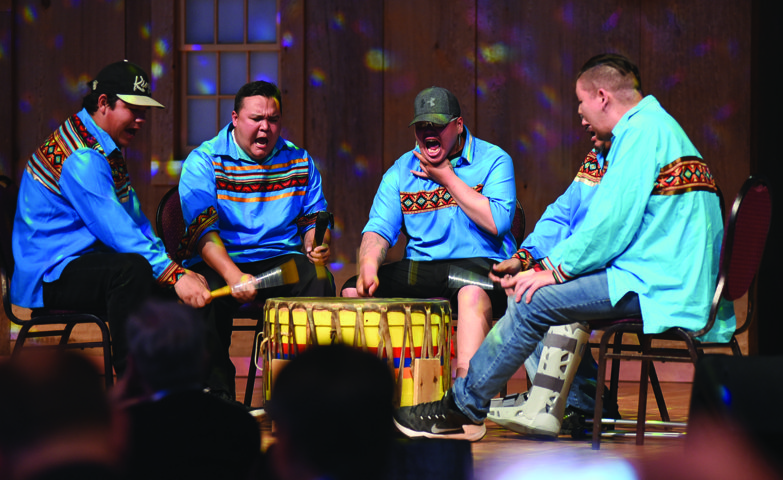
Performers: Aboriginal experience
Do you think that the other funding bodies present at the meeting will derive some inspiration from NSERC’s approach to merging basic and applied research?
We came to that conclusion through the statement of principles, because it turns out that R&D&D is also a useful framework for making the case to governments. Should one invest in fundamental research? Should one invest in applied research? If other granting bodies can provide a construct like we have, in terms of R&D&D, which demonstrates that, naturally, all of the three endeavours are essential, but one focuses on impact, then the researchers also have a responsibility. They have to think about where their fundamental research may have some value. I was in Malaysia recently, and their government officials embraced this concept because, like many other governments, they were wrestling with this issue.
R&D&D was embraced by granting councils from other countries in the last two days, and I believe they will find it useful to convince their governments that they need to support fundamental research, but as part of an entire ecosystem. Because governments have the interests of the country in mind, they’re interested in economic and societal impact, and they’re interested in jobs, jobs, jobs, as we are here.

Ottawa, Canada
The second topic in the meeting focused on capacity-building and connectivity among granting agencies worldwide. Would you like to explain some of the ideas that arose during this meeting towards achieving these aims?
Yes, one of our priorities at NSERC is going global, and that’s why the format of the Global Research Council was of great interest to us, because it helps us to go global. But going global comes with responsibilities – to work with the developing world, to share best practices and to deal with global challenges.
This meeting has been very helpful, because we could share best practices in building capacity. For example, how does one manage effective peer review? It may be obvious to some, but others may be struggling with it. How does one build capacity to move towards gender equity in the long term? We discussed the issues of achieving gender equity and improving the status of women in the research enterprise in different countries. At the meeting, Ireland, a leader in the area, shared its practices that ensure gender equity with respect to faculty appointments. So, how can Global Research Council participants learn from these and other practices shared by other countries, to build capacity and adopt best practices to empower individuals in different countries to take charge of their own destiny?
‘We’ve been very involved with developing practices for equity with respect to placement of women and under-represented groups in the academic workforce. So, we will be moving forward to develop more concrete proposals on how we can address those deficits.’
So, what came out in terms of concrete actions here? I was very impressed that we focused the discussion on research impact, and it comes back to R&D&D. One of the things we discussed was, How does one assess research impact? Here we shared practices from some countries that are ahead of others in measuring research impact. Once again, Ireland is a leader in this area. They set up a two-level evaluation system for grant applications. The first evaluates the proposal and the candidate, as we all do. The second level consists of a separate panel who evaluates the impact; it is a rigorous system, but it involves a great deal of ‘person power’, and that’s their way of asking the question: What is the impact? In this system, evaluators are also realistic about the timeframe for different types of endeavours.
For example, quantum technology is going to take a long time, maybe 20 years, for application. Drug development also takes a long time, whereas digital technology development is much faster. This is an extremely useful practice to share, because I think talking to different stakeholders about realistic timeframes is where we’ve missed the boat.
Therefore, it is very useful for different countries to hear the value of educating all stakeholders about the different ‘runways’, as I put it, for the different fields of endeavour so that one manages expectations.
The other focus was based on one of the UN’s sustainable development goals: ‘No one left behind’. This is very important for embracing diversity, and for asking the question: How can we help each other in building international efforts of the future, and in bringing everyone together? Our representation this year from the sub-Saharan African countries was outstanding, as was that of the Latin American countries. It was just phenomenal. As we build the global research family, everyone gains familiarity, relaxes, engages in more informal talks, and feels included, and that is one of the goals of the Global Research Council.
Finally, on capacity-building, we also took away some valuable lessons in how we share data. We discussed open data. How do we address that on a global scale? How do we move forward on communication? How do we move forward on collaboration? How do we move forward on developing content? These were all part of the discussions about capacity-building.
Finally, what are the main outcomes of this meeting that you hope to witness in the coming year?
We’ll be moving forward on several important issues.
On gender equity, we’ve been very involved with developing practices for equity with respect to placement of women and under-represented groups in the academic workforce. So, we will be moving forward to develop more concrete proposals on how we can address those deficits.
On going global, which is an NSERC goal for 2020, we’ll be moving forward to discuss how we can assess research impact, and to reach out to a variety of international partners using our existing network programs to forge linkages to address some major global challenges.
In fact, we’ve already started. For example, a number of the GRC member granting councils, representing 22 countries of mainly European Union countries and the developing world, have begun a collaborative effort to do research, development and delivery (R&D&D) on best practices for water purification, security, distribution, policy-making, etc. We wish to pursue those types of linkages using very large existing programs. None of us has lots of money to spare, so we have to be circumspect and critical about what we invest in, but we’ve decided to tackle some very pressing global challenges.

